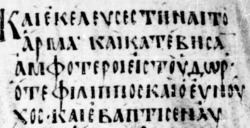Name Angelicus | Sign L Date 9th century | |
 | ||
Codex Angelicus designated by Lap or 020 (in the Gregory-Aland numbering), α 5 (von Soden), is a Greek uncial manuscript of the New Testament. Palaeographically it has been assigned to the 9th century. Formerly it was known as Codex Passionei.
Contents
Description
The codex contains text of the Acts of the Apostles, the Catholic epistles, and the Pauline epistles, on 189 parchment leaves (27 cm by 21.5 cm). The text is written in two columns per page, 26 lines per column (size of column 21.2 cm by 7.2 cm). The codex contains large lacunae in Acts 1:1-8:10; and in Hebrews 13:10-25.
It contains prolegomena, lectionary markings at the margin (for liturgical use), subscriptions at the end of each book, and στιχοι.
Text
The Greek text of this codex is a representative of the Byzantine text-type with a few non-Byzantine readings. It is one of the very earliest purely Byzantine manuscripts, and belongs to the textual family Family E. Aland placed it in Category V.
The text of Romans 16:25-27 is following 14:23, as in Codex Athous Lavrensis, Uncial 0209, Minuscule 181 326 330 451 460 614 1241 1877 1881 1984 1985 2492 2495.
In 1 Timothy 3:16 it has textual variant θεός ἐφανερώθη (God manifested) (Sinaiticuse, A2, C2, Dc, K, L, P, Ψ, 81, 104, 181, 326, 330, 436, 451, 614, 629, 630, 1241, 1739, 1877, 1881, 1962, 1984, 1985, 2492, 2495, Byz, Lect), against ὃς ἐφανερώθη (he was manifested) supported by Sinaiticus, Codex Alexandrinus, Ephraemi, Boernerianus, 33, 365, 442, 2127, ℓ 599.
History
It once belonged to the Cardinal Passionei. The manuscript was examined by Montfaucon, Bianchini, by Birch (James and 1 Corinthians), Scholz (all codex), and Ferdinand Fleck in 1833. It was collated by Tischendorf in 1843 and Tregelles in 1846. It was examined by G. Mucchio.
Wettstein and Scholz designated it by siglum G. The same siglum used Tischendorf, but in the 7th edition of his Novum Testamentum he used L. Gregory gave the number 020 ro it.
The name of the codex came from the library in Rome where it is located now, at the Biblioteca Angelica (No. 39).
